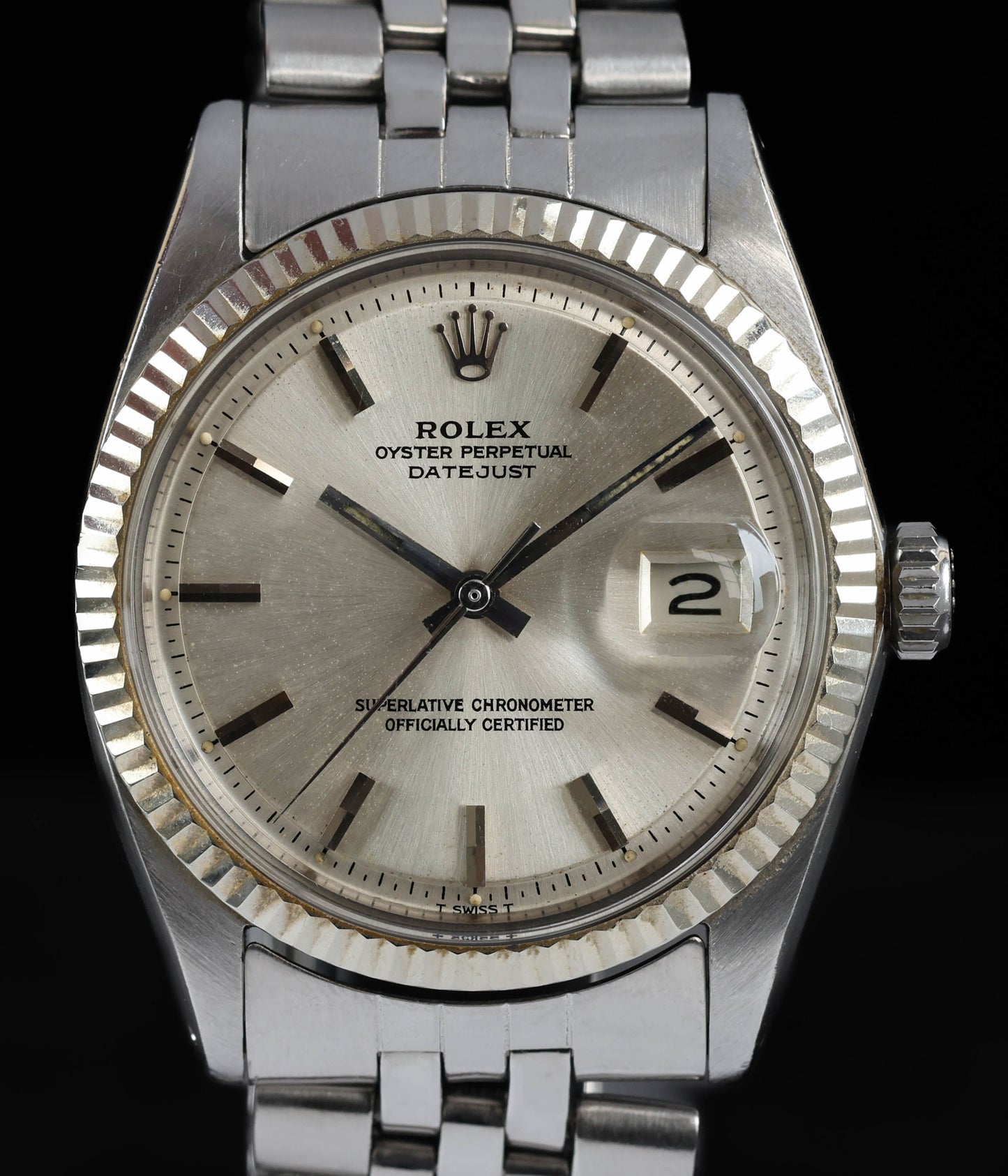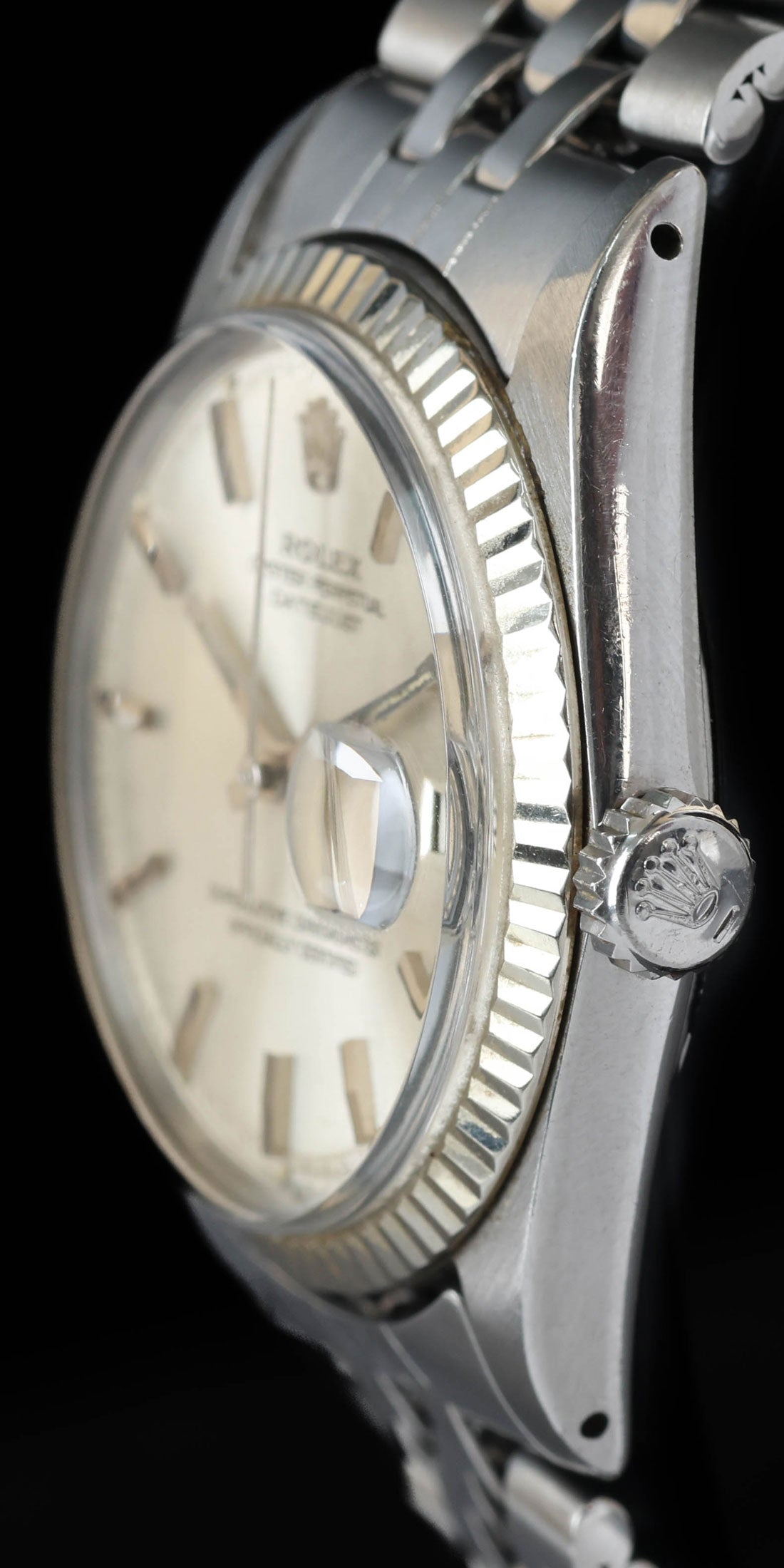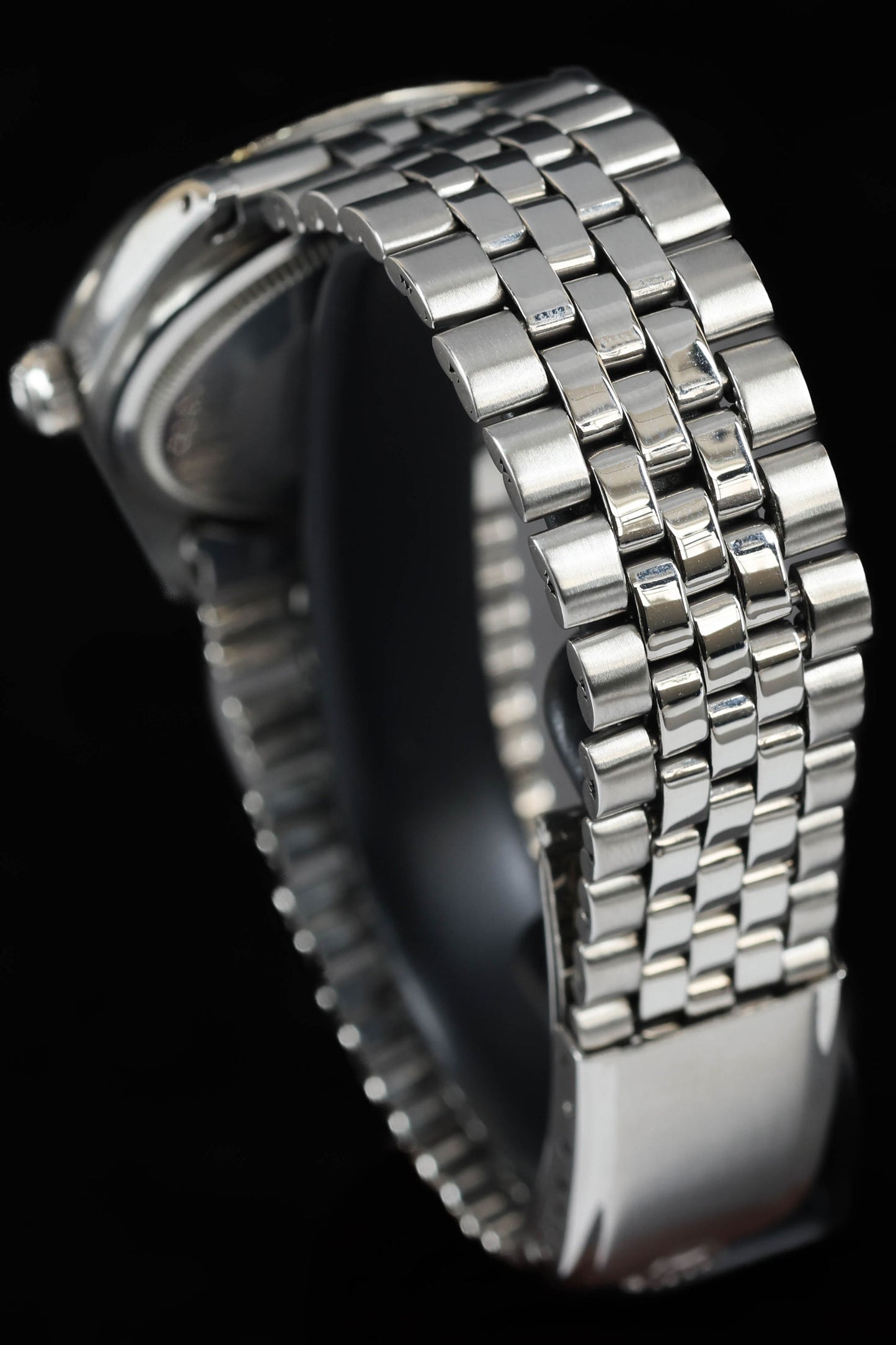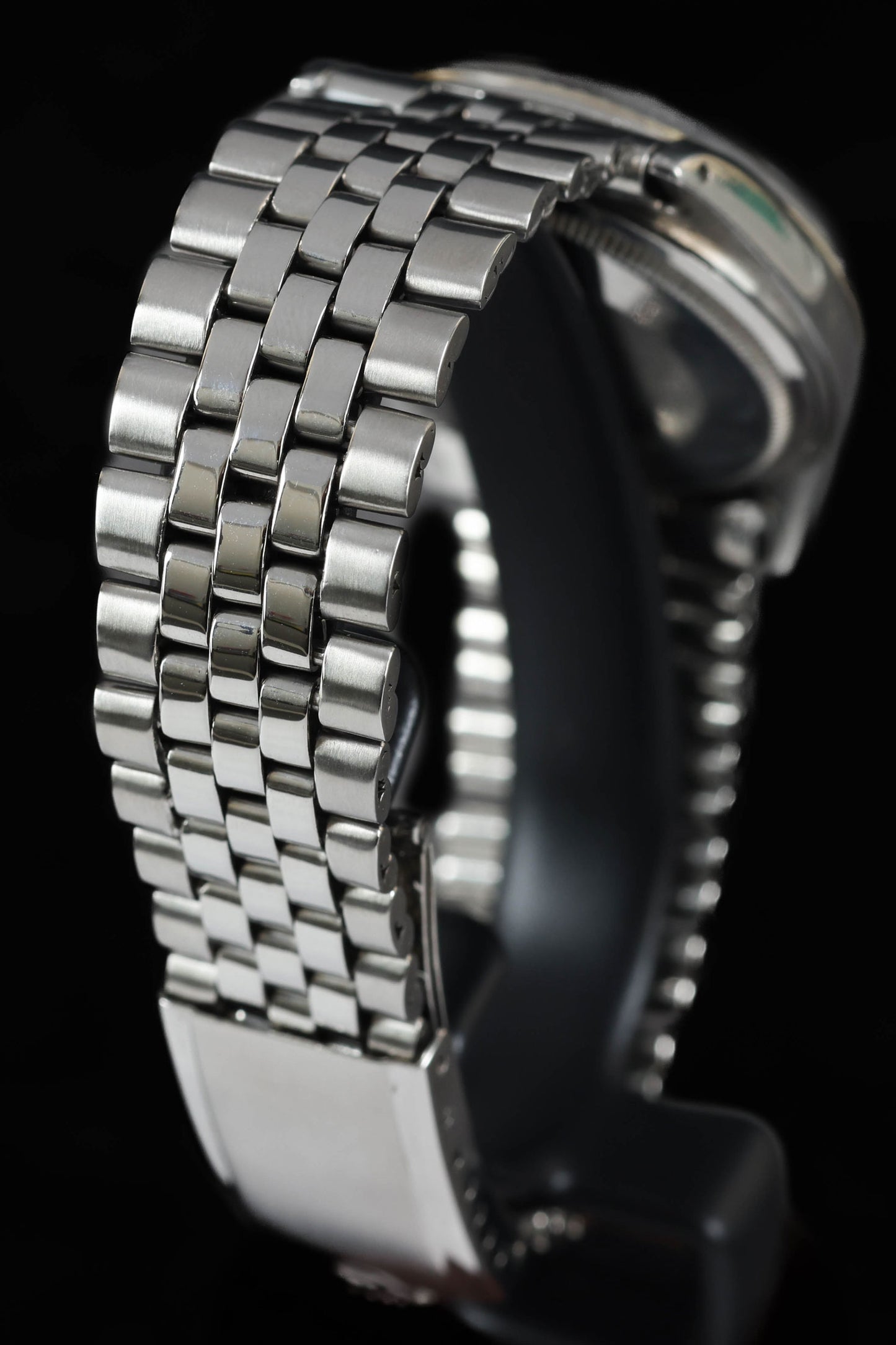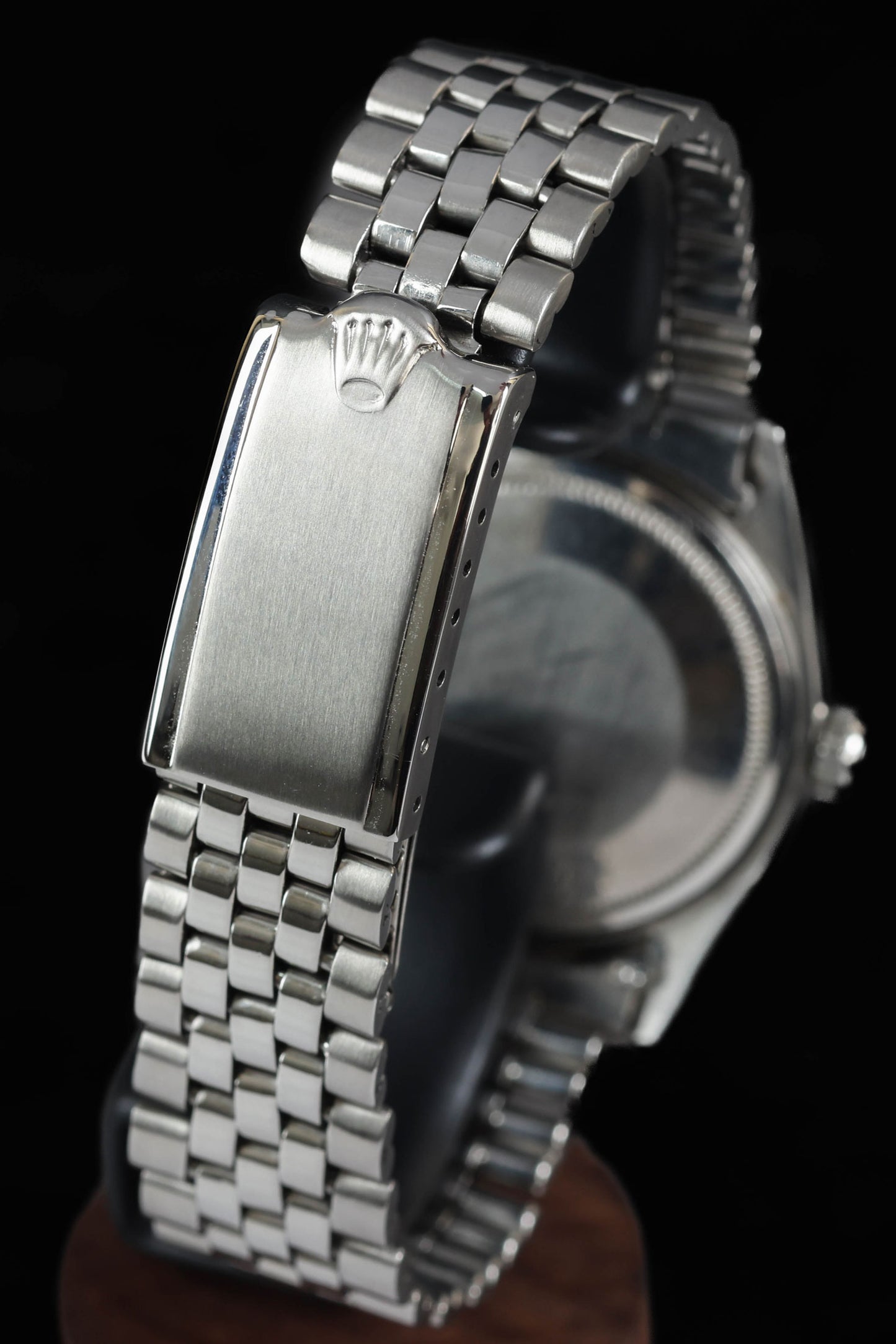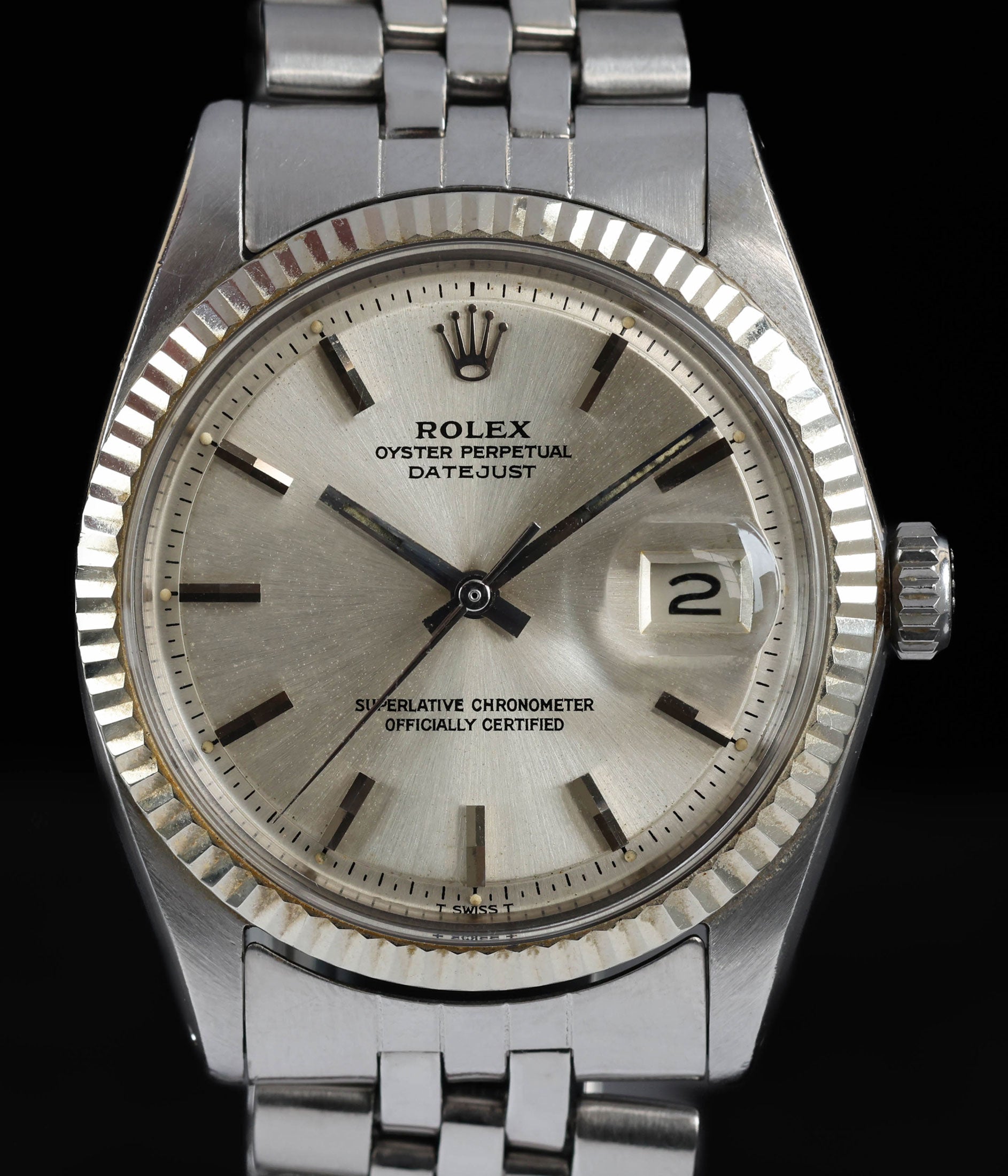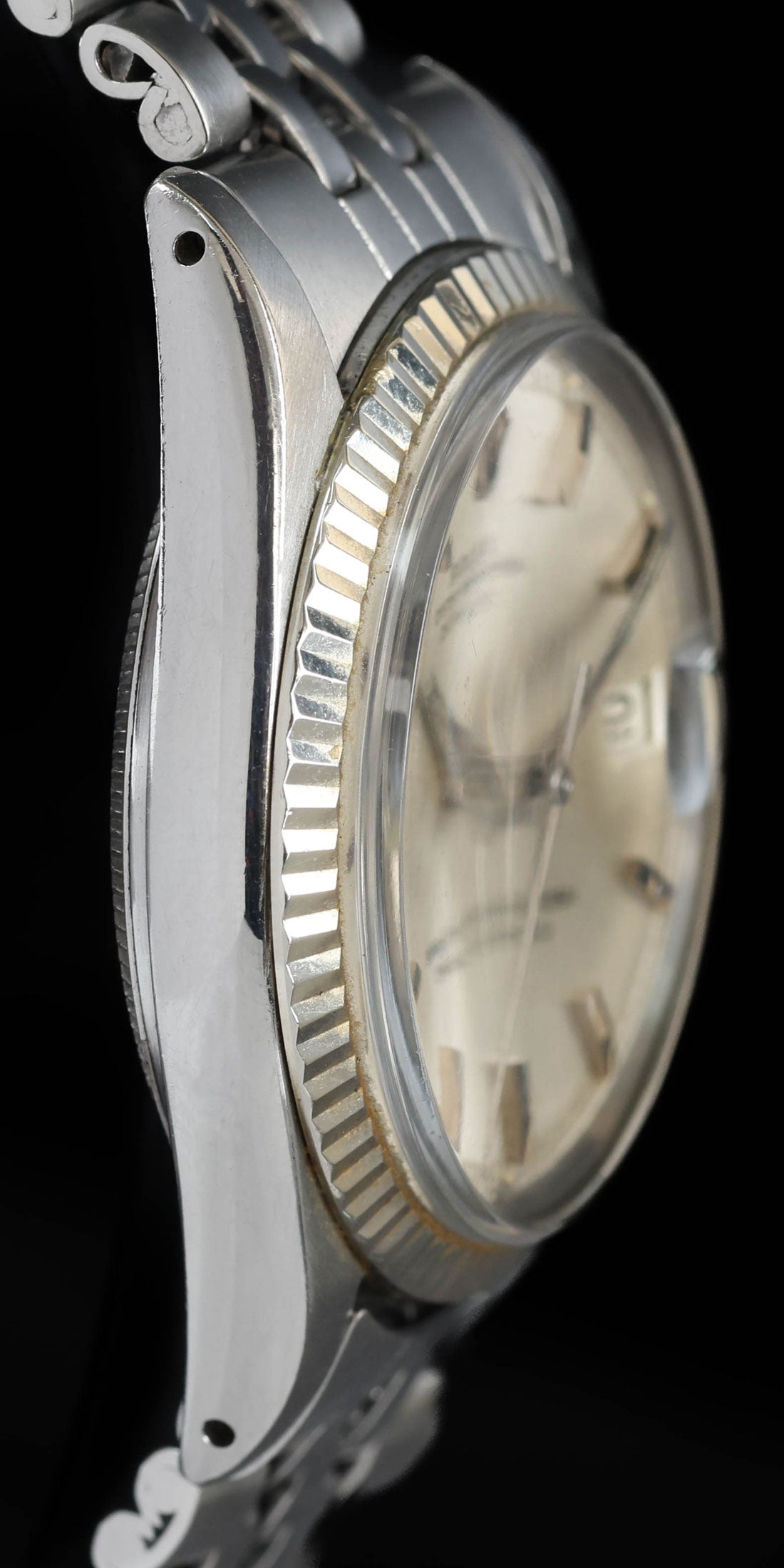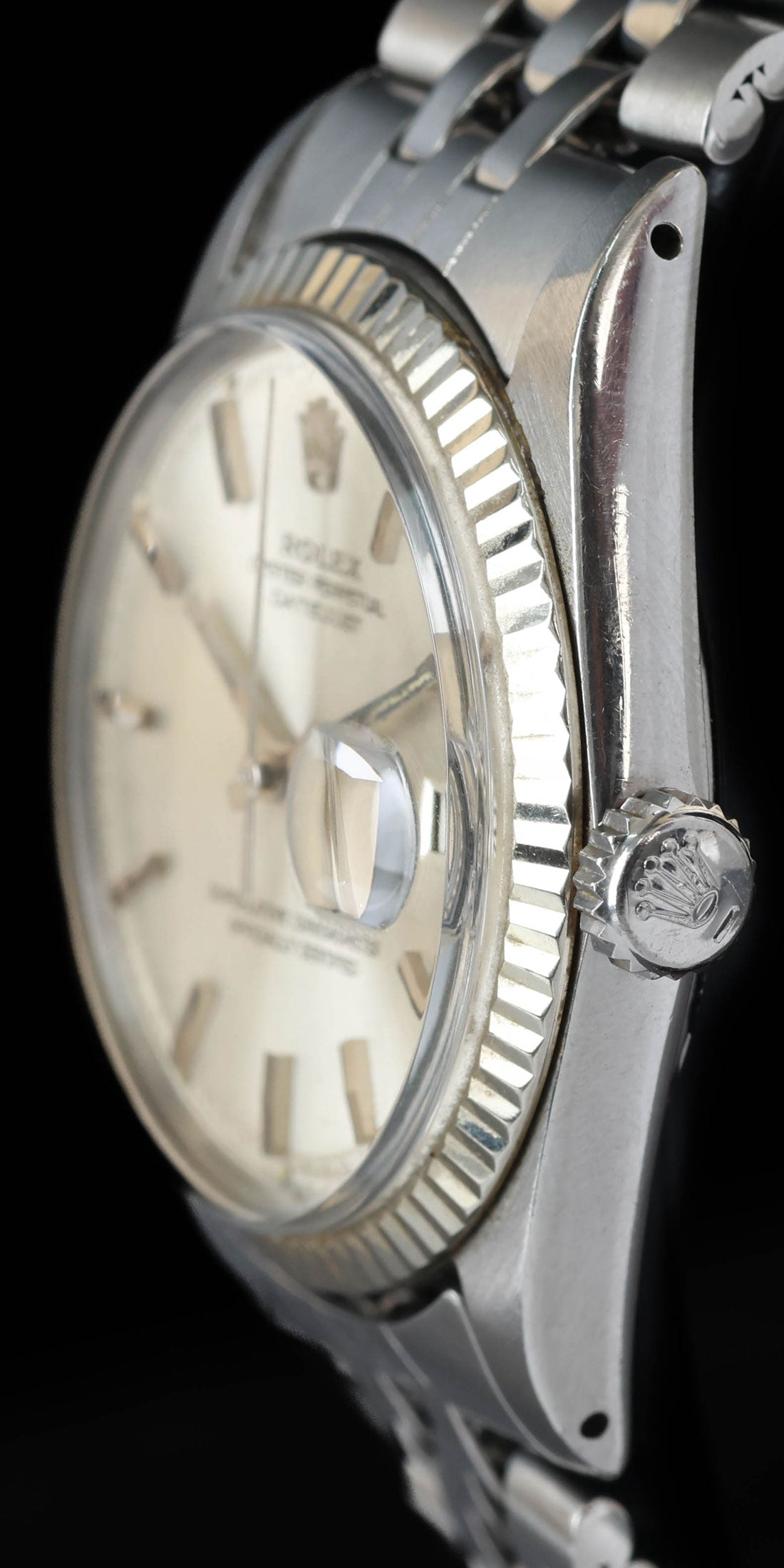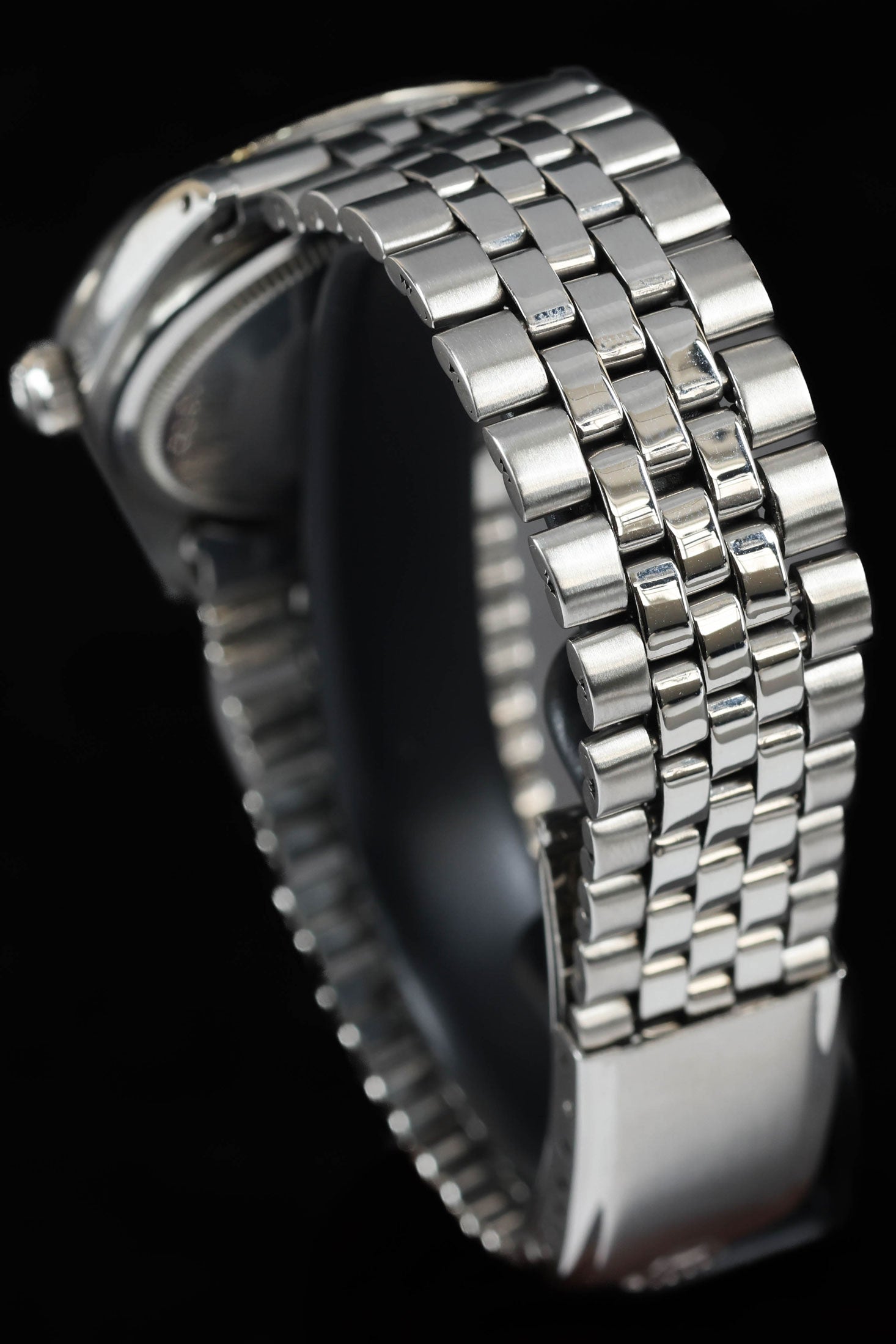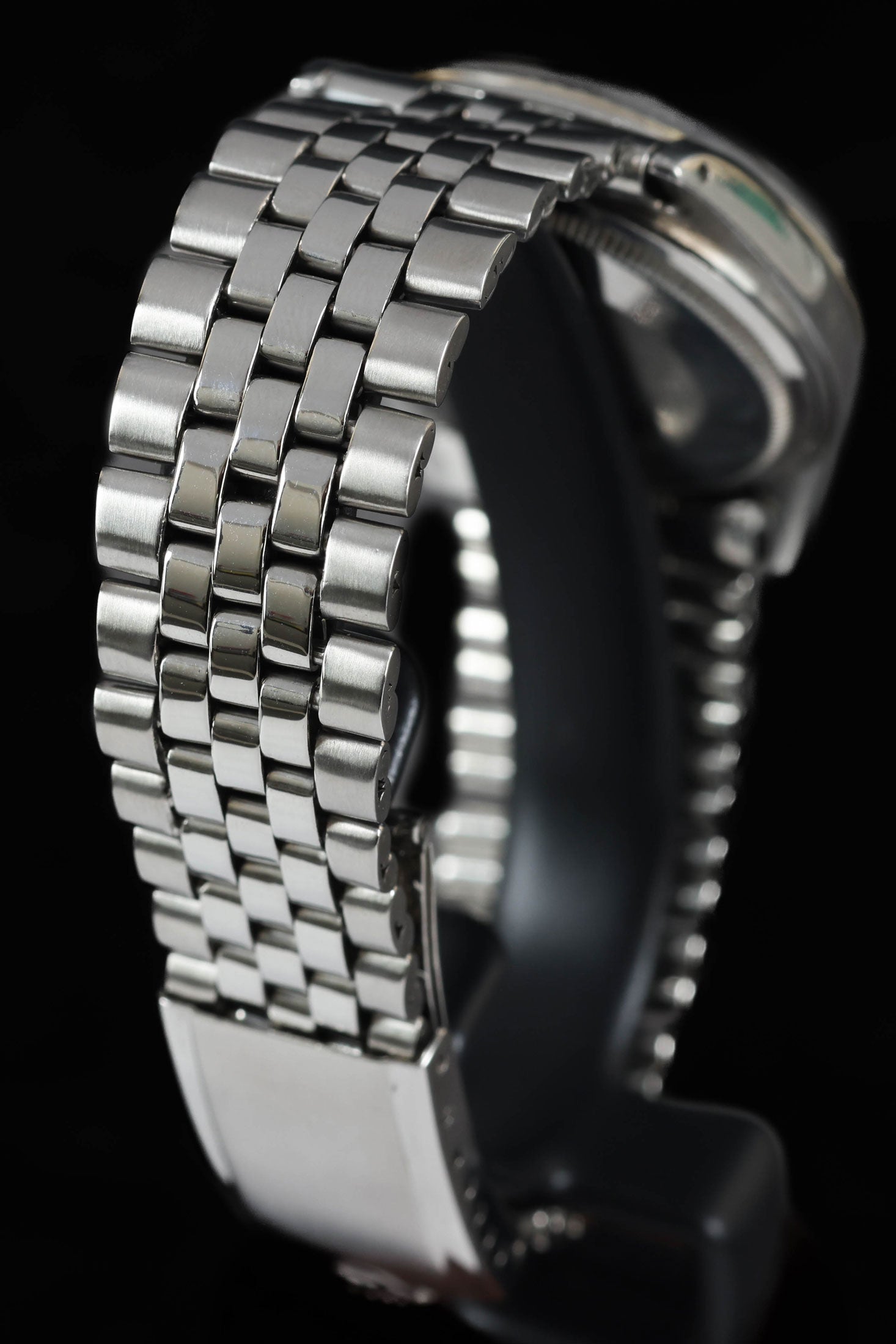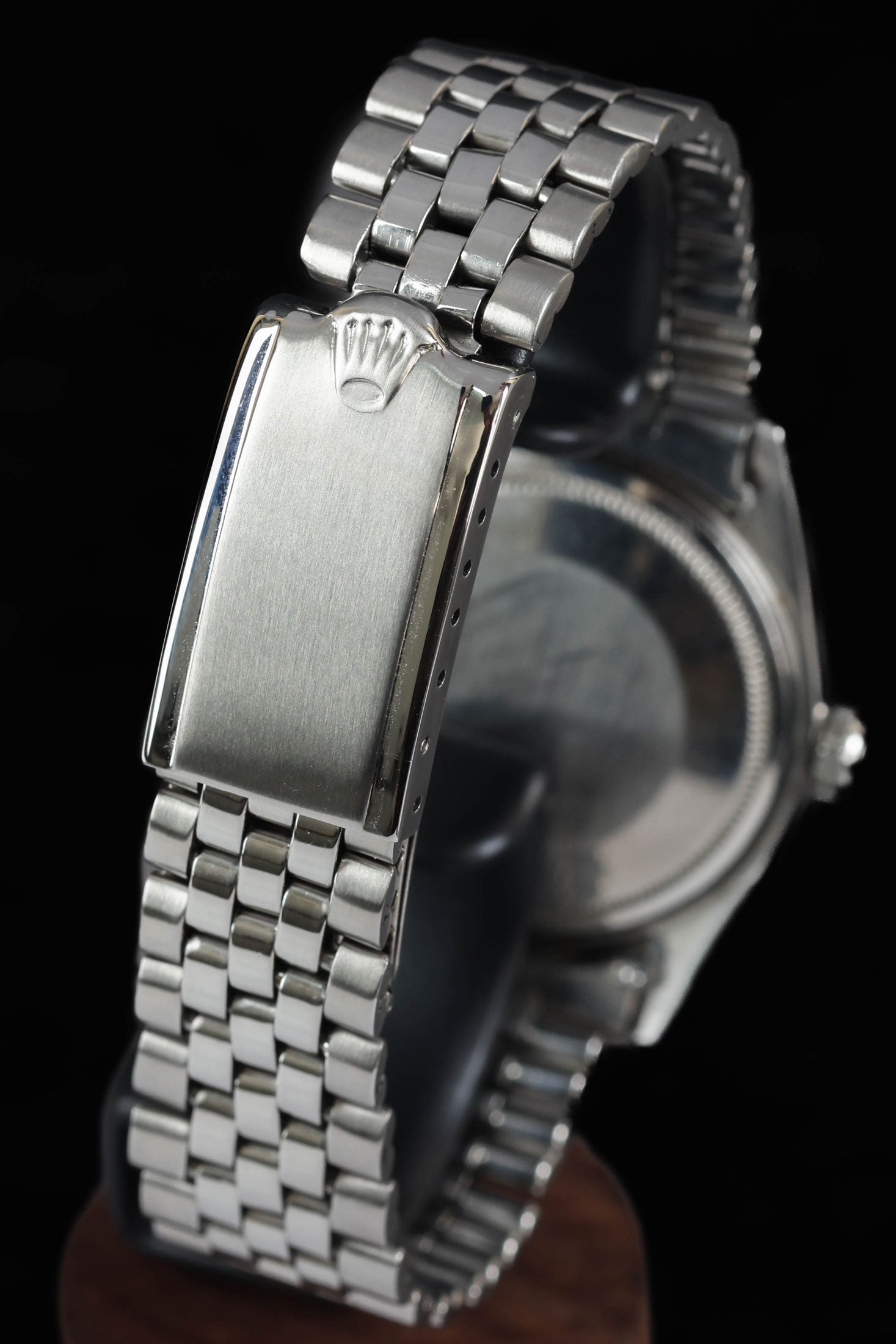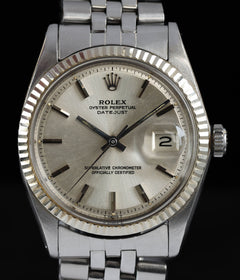Crown Vintage
Rolex Datejust 1601 36MM 'Pie Pan' 1966
Rolex Datejust 1601 36MM 'Pie Pan' 1966
Couldn't load pickup availability
This 36mm classic delivers the refined charm expected from a mid-1960s Datejust, featuring a distinct “Pie Pan” dial that subtly slopes towards the outer edge. The stainless steel case shows minimal wear on both sides, and the matching bracelet remains in strong shape for its age, with only moderate stretch. Light oxidation on the dial and hands highlights its vintage appeal, making it a practical yet historically significant choice for those seeking a timeless Rolex design.
Share
Why we love this watch
Why we love this watch
The Rolex Datejust 1601 with a Silver Dial from the Mid-1960s: A Factual Exploration
Introduced in 1945 to mark Rolex’s 40th anniversary, the Datejust quickly became a cornerstone of the brand’s catalogue. By fusing a date aperture, self-winding movement, and water-resistant Oyster case, Rolex produced a watch that defined a new level of everyday mechanical convenience. Over the decades, multiple Datejust references emerged, each with its own technical and aesthetic nuances. Among these, the 1601 reference is especially noteworthy for its timeless aesthetic. One particularly appealing variant from the mid-1960s features a silver dial, balancing understated elegance with Rolex’s enduring quality.
1. The 1960s Context
By the mid-1960s, the Datejust had already spent over two decades on the market, firmly establishing itself as a central model in Rolex’s roster. Its refinement in timekeeping accuracy, combined with robust waterproofing, helped secure the Datejust’s reputation as a refined yet practical choice.
Whereas other references—such as the Day-Date—offered both day and date indications, the Datejust captured a wider demographic by providing just the date display, balanced with classic, easily recognisable styling. Rolex’s commitment to incremental improvements and continuity in core design elements meant that each new iteration of the Datejust built upon a long-standing tradition of reliability and elegance.
2. Birth of the 160x Series
Before the advent of the 1601, earlier Datejust models had demonstrated the merits of pairing an automatic winding system with a simple, highly legible date display. These earlier iterations established the idea that combining day-to-day utility with mechanical precision could result in a versatile dress-sport hybrid. By the late 1950s and early 1960s, Rolex introduced the 160x series, which streamlined the design and improved overall performance. This line featured:
• 1600: Sporting a smooth bezel
• 1601: Presenting a fluted gold bezel
• 1603: Equipped with an engine-turned bezel
The reference number typically indicated the watch’s bezel style—an important distinction for those who relish the subtle variations within the same model range. For the 1601, its fluted bezel (usually in white or yellow gold) contributed an extra layer of formality without sacrificing the Datejust’s inherently reserved aesthetic. Light catching the fluted edges imparts a striking appeal, further showcasing the intricacy of Rolex’s finishing processes.
3. A Mid-1960s Milestone
By this point in the decade, Rolex had solidified its design language. The Datejust exemplified that ethos: neither too large nor too small, water-resistant yet dressy, and robust on the inside without gratuitous ornamentation. The watch’s hallmark was its date window at three o’clock, augmented by the Cyclops lens for better legibility. The piece in question, produced in this era, reflects the industrial and cultural influences that Rolex responded to at the time.
In an environment where the mechanical watch still reigned supreme, a Datejust wearer typically needed something reliable for both personal and professional use. The watch achieved an admirable balance, sufficient for those who liked to dive into active pursuits, while also remaining understated enough to pair with formal attire. While not classified as a diver or pilot’s watch, the Datejust featured the dependable Oyster case design that resisted moisture and debris—an integral element behind the watch’s broad appeal.
4. An Overview of the 1601 Reference
The 1601 characteristically employs a 36mm Oyster case—a size that was standard for a men’s watch in that era and continues to be viewed favourably by many today. The presence of a fluted bezel in precious metal acted as the reference’s main point of visual distinction. The dial selection included various hues, but silver and champagne dials emerged as favourites. A silver dial from the mid-1960s version of the 1601 frequently showcased baton hour markers with fine luminous strips (most likely tritium), offering legibility in dim light without excessive brightness.
A vital element of the Datejust’s profile is the acrylic crystal. Rather than sapphire, which Rolex later adopted, acrylic was used to maintain impact resistance and reduce glare. The iconic Cyclops lens sits atop the date window, allowing the user to read the date at a glance. Although today’s watch aficionados might take this for granted, the Cyclops was a novel convenience feature in its time.
5. Movement and Mechanics
Driving the 1601 was a calibre from the Rolex 15xx family—either the Calibre 1565 or a variant of the Calibre 1570, depending on exact production year. Operating at 18,000 vibrations per hour, these movements represented significant technological success for Rolex. They introduced a robust automatic winding mechanism with a bi-directional rotor, enhancing consistent power winding throughout the day.
A noteworthy aspect of the 15xx movements from this era is the lack of a quickset date function. Adjusting the date requires rotating the hands past midnight repeatedly to reach the correct date. While this might appear tedious by contemporary standards, the robust engineering of the movement itself stood the test of time. The reliability and simplicity of the 15xx line earned it a strong reputation among watchmakers and owners.
6. The Silver Dial of the Period
Although Rolex offered multiple dial colours, the silver option remains especially popular for a mid-1960s Datejust 1601. This colour both blends seamlessly with the gold bezel (if it’s a two-tone version) and suits an all-steel or steel-and-white-gold combination. Depending on light conditions, the silver dial can transition from a subdued glow to a faint sunburst effect, giving it a subtle dynamism.
With vintage pieces, some patina or slight discolouration might develop over decades. The luminous material used on the markers and hands can take on a soft cream hue, often prized by those who value authenticity. While signs of ageing on vintage watches can be divisive, many appreciate this gentle evolution of appearance as proof of the timepiece’s longevity and character.
7. Bracelet Configurations
During this era, the Datejust 1601 typically came attached to either the Jubilee or Oyster bracelet. The Jubilee bracelet provided a more ornate design—its five-piece links draping elegantly around the wrist—emphasising the model’s dressier aspect. The Oyster bracelet, on the other hand, featured a three-piece link construction that could hint at a sportier sensibility.
Riveted or folded-link variants were common in the mid-1960s, each with slightly different engineering. Enthusiasts of vintage Rolex frequently discuss the nuances of these early bracelet styles, given that correct period components can significantly affect collectability. Both designs, whether Jubilee or Oyster, highlight the brand’s attention to detail and remain comfortable for extended wear.
8. Why the 1601 Matters Historically
The 1601 bridged the gap between older Datejust references and the more updated pieces that would appear in subsequent decades. At a point when Rolex was simultaneously crafting specialised tool watches (Submariners, GMT-Masters, etc.), the Datejust carried on as the refined all-rounder. Its enduring design language, amplified by incremental improvements, demonstrates Rolex’s commitment to continuity in core models.
This consistency also signals the confidence Rolex had in the Datejust concept: an approachable yet sophisticated watch that could handle everyday use gracefully. Even as the brand ventured into more complex or specialised offerings, the 1601’s strong presence in the range persisted, proving that the Datejust formula had durable appeal.
9. Condition and Market Considerations
When reviewing a mid-1960s Datejust 1601, collectors scrutinise the condition of its case, bezel, dial, and bracelet. Signs of over-polishing, especially around the fluted edges or lugs, can reduce a piece’s attraction. Sharp, well-preserved lines indicate minimal intervention and often command a premium.
Equally significant is dial condition. A dial that has maintained its colour and has only natural patina is commonly deemed more valuable than one that’s heavily refinished or replaced. Box and papers, while desirable, are less common for watches of this age. However, when present, they can elevate the watch’s provenance and desirability.
Compared to certain Rolex sports models, the Datejust might not always generate the highest prices. Nonetheless, interest in vintage Datejusts has grown. Their subtle sophistication and daily practicality make them enticing for many buyers seeking an iconic Rolex that isn’t overshadowed by the brand’s professional references.
10. Wearing a Mid-1960s 1601 Today
A well-preserved 1601 from this era can still keep time accurately, provided it has undergone appropriate servicing by a watchmaker who appreciates vintage pieces. The 36mm size, often considered moderate by modern standards, offers a comfortable wear for those who favour a traditional wrist presence. The watch harmonises well with both casual and formal attire, underscoring its versatility.
Servicing older movements requires a watchmaker adept in handling vintage Rolex parts, particularly for lumed hands and dials. The acrylic crystal can be polished to remove minor scratches, but bigger cracks or deep marks might warrant a cautious replacement. Many owners prefer to keep original components, including crystals, for authenticity’s sake, but balanced judgements are common when ensuring long-term reliability.
11. Broader Rolex Landscape of the Time
During the same period, Rolex introduced and refined professional series watches, positioning the brand for explorers, divers, pilots, and racing drivers. Nevertheless, the Datejust remained a cornerstone model, earning consistent acclaim for its ability to meld practicality with quiet elegance. Its robust fundamentals (Oyster case, automatic movement, functional date window) meant it served everyday requirements without sacrificing style.
That blending of qualities proved resilient. The Datejust, with the 1601 reference as a clear example, showcased that Rolex did not need to compromise on sophistication to deliver real-world utility. This ethos guided many subsequent decades of production, with the Datejust line seeing only measured, purposeful updates over time.
12. Conclusion
Building on the Datejust legacy established in the late 1940s, the 1601 integrated incremental advancements and a fluted bezel for additional elegance. Powered by a robust 15xx series calibre, it met everyday demands while retaining a level of finish and detail that made it stand out in its day—and still does.
Its silver dial, with subtle reflections and evolving patina, brings a level of sophistication that suits a variety of occasions. The 36mm size allows for comfortable long-term wear, while the choice of Jubilee or Oyster bracelet can shift the watch’s overall feel. Over half a century later, examples from this era remind watch enthusiasts of Rolex’s enduring approach to craftsmanship. Whether sought for its vintage design language or historical significance, the 1601 captures the essence of a past generation’s skill and style, persisting as a notable piece within Rolex’s Datejust lineage.
Case & Bracelet
Case & Bracelet
- Case & bracelet in great condition, minimal wear on either sides of the case.
- Bracelet in great condition for its age, some stretch noticeable.
Dial & Hands
Dial & Hands
Dial & hands have light oxidisation.
Warranty & Condition
Warranty & Condition
Crown Vintage Watches provides a minimum 3-month mechanical warranty on pre-owned watches, from the date of purchase.
The warranty covers mechanical defects only.
The warranty does not cover damages such as scratches, finish, crystals, glass, straps (leather, fabric or rubber damage due to wear and tear), damage resulting from wear under conditions exceeding the watch manufacturer’s water resistance limitations, and damage due to physical and or accidental abuse.
Please note, water resistance is neither tested nor guaranteed.
Shipping and insurance costs for warranty returns to us must be covered by the customer. Returns must be shipped via traceable courier. Return shipment must be pre-paid and fully insured. Collect shipping will be refused. In case of loss or damages, the customer is liable.
Our Pledge
At Crown Vintage Watches, we stand by the authenticity of every product we sell. For added peace of mind, customers are welcome to have items independently authenticated at their own expense.
Condition
Due to the nature of vintage timepieces, all watches are sold as is. We will accurately describe the current condition and working order of all watches we sell to the best of our ability.
Shipping & Refund
Shipping & Refund
